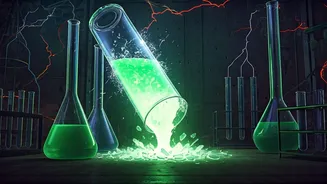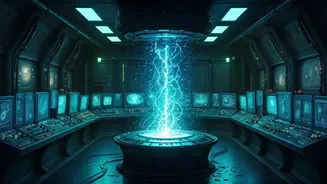Gravity's Grip Ignored
One of the most fundamental forces in the universe, gravity, is frequently ignored or misunderstood in films. Space movies, for instance, often depict
explosions in a way that defies the laws of physics. In reality, explosions in space wouldn't cause the dramatic, fiery displays we see on screen. Instead, they would disperse in a near-invisible cloud of expanding gas and debris, since there's no air to provide the characteristic flame. Films may also portray gravity as a switch that can be easily turned on and off, a feat not possible in the real world. The lack of gravity also causes problems. The lack of pull leads to items floating. This is often overlooked by movies to heighten drama and the audience gets to suspend their belief.
Sound in Space
Another common area of scientific inaccuracy in movies is the portrayal of sound in space. Because sound waves require a medium, such as air, to travel, there would be no sound in the vacuum of space. Yet, many films feature the dramatic sounds of explosions, laser fire, and spaceship movements. While adding to the visual spectacle, these sound effects are fundamentally impossible. The silence of space, however, might not be as visually appealing, so sound effects continue to be a prevalent tool for the cinematic experience.
Time Travel Troubles
Time travel, a popular science fiction trope, is often riddled with scientific inconsistencies. While the concept is theoretically possible under certain conditions (like extreme gravity or near light-speed travel, it is not the simple door that films make it out to be. The complexities include paradoxes and violations of the laws of physics. Films rarely account for issues like the conservation of energy and the creation of matter out of nothingness. This often makes for engaging stories, but not scientifically accurate ones, as they often play with the very nature of cause and effect. The challenge is the scientific rigor versus the entertainment value.
Instantaneous Communication
Instantaneous communication across vast distances is another frequent inaccuracy. Despite the limitations of the speed of light, movies regularly depict characters communicating with each other across light-years with no noticeable delay. In reality, any communication between stars, planets, or even satellites would involve a time delay, which, depending on the distance, could range from minutes to years. If the scenario is meant to be futuristic, this type of delay could be bypassed, but the science fiction movies are not always clear or detailed about this. The effect of the delay could make for slower plots, so it is often ignored in favor of quick dialogue.
Disease and Viruses
Medical inaccuracies are common, with diseases and viruses being simplified or misrepresented for dramatic effect. The speed of disease progression, the effectiveness of treatments, and the nature of viruses are often exaggerated or altered to create more suspenseful narratives. For example, a virus that wipes out humanity in a matter of days is not entirely scientifically accurate. The symptoms are often fast, without the slow-burning development or detailed incubation periods that typically characterize viral outbreaks. The science of disease often gives way to the need for a fast-paced narrative.
The Speed of Light
The speed of light is frequently underestimated in film, where spacecraft often travel at far greater velocities than is physically possible. If a spacecraft were to travel even near the speed of light, the effects would be dramatic, including significant time dilation, where time would pass slower for the travelers relative to the outside world. This also leads to the misconception of space travel between stars, where the movie presents instantaneous effects, rather than years of travel time, which is very unrealistic. This is a scientific shortcut the movies often take. The science has been altered in the interest of the audience's entertainment.
Implausible Explosions
Explosions, which are meant to create a high degree of drama, rarely adhere to the laws of physics, often appearing more dramatic than what is feasible. The size, intensity, and effects of explosions, whether in space or on Earth, are often wildly exaggerated. The sheer force of an explosion, the spread of debris, and the resulting aftermath are commonly misrepresented. Even with the addition of visual and sound effects, the reality is almost always very different. The goal is a good spectacle. The more impressive the visual effect, the more entertaining the audience finds it. So, the reality often takes a back seat.
Genetic Engineering Errors
Genetic engineering is another topic prone to significant inaccuracies. The complex science behind gene manipulation is often overly simplified, and the consequences of genetic modifications are often misrepresented to fuel dramatic narratives. Rapid, and often immediate, changes and adaptations in organisms are often showcased, without considering the painstaking and incremental processes involved. Genetic engineering takes time and the final results are not as visually clear as depicted in the movies. It is another example where the truth often gives way to entertainment. The goal is to hold the audience's attention and to keep them entertained.
Chemical Reactions
Chemical reactions in films also often present problems in the interest of entertainment. The speed, effects, and the outcomes of reactions are often incorrect. Reactions portrayed may happen instantaneously, when in reality, many chemical reactions take time. Even the effects of the reactions are exaggerated, often resulting in dramatic displays of color, smoke, and explosions that would not occur in reality. This allows filmmakers to increase the entertainment value. The goal is to create visual moments that captivate the audience, which often results in scientific inaccuracies.
Extreme Weather Misconceptions
Extreme weather events, such as hurricanes, tornadoes, and blizzards, are portrayed in ways that often exaggerate their effects and impact. Movies typically present these events with a focus on visual destruction, ignoring the intricacies of weather patterns. The intensity and duration of these events are often heightened for dramatic effect. The speed at which events unfold may be far beyond what is physically possible. The goal is to generate suspense. As the movie makers continue to create more exciting experiences, they often sacrifice scientific accuracy to achieve their goals and to draw in larger audiences.









